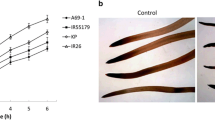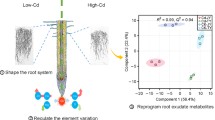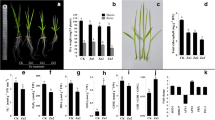Abstract
Plants are routinely subjected to multiple environmental stresses that constrain growth. Zinc (Zn) deficiency and high bicarbonate are two examples that co-occur in many soils used for rice production. Here, the utility of metabolomics in diagnosing the effect of each stress alone and in combination on rice root function is demonstrated, with potential stress tolerance indicators identified through the use of contrasting genotypes. Responses to the dual stress of combined Zn deficiency and bicarbonate excess included greater root solute leakage, reduced dry matter production, lower monosaccharide accumulation and increased concentrations of hydrogen peroxide, phenolics, peroxidase and N-rich metabolites in roots. Both hydrogen peroxide concentration and root solute leakage were correlated with higher levels of citrate, allantoin and stigmasterol. Zn stress resulted in lower levels of the tricarboxylic acid (TCA) cycle intermediate succinate and the aromatic amino acid tyrosine. Bicarbonate stress reduced shoot iron (Fe) concentrations, which was reflected by lower Fe-dependent ascorbate peroxidase activity. Bicarbonate stress also favoured the accumulation of the TCA cycle intermediates malate, fumarate and succinate, along with the non-polar amino acid tyrosine. Genotypic differentiation revealed constitutively higher levels of d-gluconate, 2-oxoglutarate and two unidentified compounds in the Zn-efficient line RIL46 than the Zn-inefficient cultivar IR74, suggesting a possible role for these metabolites in overcoming oxidative stress or improving metal re-distribution.





Similar content being viewed by others
Abbreviations
- ADH:
-
Alcohol dehydrogenase
- ANOVA:
-
Analysis of variance
- APX:
-
Ascorbate peroxidase
- DI:
-
De-ionised
- DMA:
-
Deoxymugineic acid
- EDTA:
-
Ethylenediaminetetraacetic acid
- GC–MS:
-
Gas chromatography–mass spectrometry
- NAD:
-
Nicotinamide adenine dinucleotide
- NBT:
-
Nitroblue tetrazolium
- PLS-DA:
-
Partial least-squares discriminant analysis
- POX:
-
Peroxidase
- QTL:
-
Quantitative trait loci
- RI:
-
Retention index
- RIL:
-
Recombinant inbred line
- ROS:
-
Reactive oxygen species
- SOD:
-
Superoxide dismutase
- TCA:
-
Tricarboxylic acid
References
Agarwal P, Arora R, Ray S, Singh AK, Singh VP, Takatsuji H, Kapoor S, Tyagi AK (2007) Genome-wide identification of C2H2 zinc-finger gene family in rice and their phylogeny and expression analysis. Plant Mol Biol 65:467–485
Ahuja I, de Vos RCH, Bones AM, Hall RD (2010) Plant molecular stress responses face climate change. Trends Plant Sci 15:664–674
Ainsworth EA, Gillespie KM (2007) Estimation of total phenolic content and other oxidation substrates in plant tissues using Folin–Ciocalteu reagent. Nat Protoc 2:875–877
Alamillo JM, Diaz-Leal JL, Sanchez-Moran MV, Pineda M (2010) Molecular analysis of ureide accumulation under drought stress in Phaseolus vulgaris L. Plant Cell Environ 33:1828–1837
Alloway B (2008) Zinc in soils and crop nutrition. International Zinc Association and International Fertilizer Industry Association, Brussels
Arnold T, Kirk GJ, Wissuwa M, Frei M, Zhao FJ, Mason TF, Weiss DJ (2010) Evidence for the mechanisms of zinc uptake by rice using isotope fractionation. Plant Cell Environ 33:370–381
Bhalla R, Narasimhan K, Swarup S (2005) Metabolomics and its role in understanding cellular responses in plants. Plant Cell Rep 24:562–571
Broadley MR, White PJ, Hammond JP, Zelko I, Lux A (2007) Zinc in plants. New Phytol 173:677–702
Brychkova G, Alikulov Z, Fiuhr R, Sagi M (2008) A critical role for ureides in dark and senescence-induced purine remobilization is unmasked in the Atxdh1 Arabidopsis mutant. Plant J 54:496–509
Bunik V, Fernie AR (2009) Metabolic control exerted by the 2-oxoglutarate dehydrogenase reaction: a cross-kingdom comparison of the crossroad between energy production and nitrogen assimilation. Biochem J 422:405–421
Cakmak I (2000) Role of zinc in protecting plant cells from reactive oxygen species. New Phytol 146:185–205
Cakmak I, Marschner H (1992) Magnesium deficiency and high light intensity enhance activities of superoxide dismutase, ascorbate peroxidase, and glutathione reductase in bean leaves. Plant Physiol 98:1222–1227
Chen W, Yang X, He Z, Feng Y, Hu F (2008) Differential changes in photosynthetic capacity, 77 K chlorophyll fluorescence and chloroplast ultrastructure between Zn-efficient and Zn-inefficient rice genotypes (Oryza sativa) under low zinc stress. Physiol Plant 132:89–101
Dobermann A, Fairhurst TH (2000) Nutrient disorders and nutrient management. Potash and Phosphate Institute, Potash and Phosphate Institute of Canada and International Rice Research Institute, Singapore
Donnini S, Prinsi B, Negri AS, Vigani G, Espen L, Zocchi G (2010) Proteomic characterization of iron deficiency responses in Cucumis sativus L. roots. BMC Plant Biol 10:268
Fiehn O, Kopka J, Dörmann P, Altmann T, Trethewey RN, Willmitzer L (2000) Metabolite profiling for plant functional genomics. Nat Biotechnol 18:1157–1161
Fiehn O, Wohlgemuth G, Scholz M, Kind T, Lee do Y, Lu Y, Moon S, Nikolau B (2008) Quality control for plant metabolomics: reporting MSI-compliant studies. Plant J 53:691–704
Frei M, Wang Y, Ismail A, Wissuwa M (2010) Biochemical factors conferring shoot tolerance to oxidative stress in rice grown in low zinc soil. Funct Plant Biol 37:74–84
Gheldof N, Wang XH, Engeseth NJ (2002) Identification and quantification of antioxidant components of honeys from various floral sources. J Agric Food Chem 50:5870–5877
Giannopolitis N, Ries SK (1977) Superoxide dismutase. I. Occurrence in higher plants. Plant Physiol 59:309–314
Gill SS, Tuteja N (2010) Reactive oxygen species and antioxidant machinery in abiotic stress tolerance in crop plants. Plant Physiol Biochem 48:909–930
González I, Lê Cao K-A, Déjean S (2010) mixOmics: Omics Data Integration Project. http://www.math.univ-toulouse.fr/~biostat/mixOmics/. Accessed 2 September 2011
Gullberg J, Jonsson P, Nordström A, Sjöström M, Moritz T (2004) Design of experiments: an efficient strategy to identify factors influencing extraction and derivatization of Arabidopsis thaliana samples in metabolomic studies with gas chromatography/mass spectrometry. Anal Biochem 331:283–295
Hacisalihoglu G, Kochian LV (2003) How do some plants tolerate low levels of soil zinc? Mechanisms of zinc efficiency in crop plants. New Phytol 159:341–350
Haenlein M, Kaplan AM (2004) A beginner’s guide to partial least squares analysis. Underst Stat 3:283–297
Hajiboland R, Yang XE, Romheld V, Neumann G (2005) Effect of bicarbonate on elongation and distribution of organic acids in root and root zone of Zn-efficient and Zn-inefficient rice (Oryza sativa L.) genotypes. Environ Exp Bot 54:163–173
Han D, Kim SJ, Kim SH, Kim DM (1998) Repeated regeneration of degraded red beet juice pigments in the presence of antioxidants. J Food Sci 63:69–72
Hernandez LE, Cooke DT (1997) Modification of the root plasma membrane lipid composition of cadmium-treated Pisum sativum. J Exp Bot 48:1375–1381
Holländer-Czytko H, Grabowski J, Sandorf I, Weckermann K, Weiler EW (2005) Tocopherol content and activities of tyrosine aminotransferase and cystine lyase in Arabidopsis under stress conditions. J Plant Physiol 162:767–770
Igaue I, Yagi M (1982) Alcohol dehydrogenase from cultured rice cells. Plant Cell Physiol 23:213–225
Ismail AM, Heuer S, Thomson JT, Wissuwa M (2007) Genetic and genomic approaches to develop rice germplasm for problem soils. Plant Mol Biol 65:547–570
Jelali N, Salah IB, M’sehli W, Donnini S, Zocchi G, Gharsalli M (2011) Comparison of three pea cultivars (Pisum sativum) regarding their responses to direct and bicarbonate-induced iron deficiency. Sci Hort 129:548–553
Jones DL, Owen AG, Farrar JF (2002) Simple method to enable the high resolution determination of total free amino acids in soil solutions and soil extracts. Soil Biol Biochem 34:1893–1902
Kataria HR, Wilmsmeier B, Buchenauer H (1997) Efficacy of resistance inducers, free-radical scavengers and an antagonistic strain of Pseudomonas fluorescens for control of Rhizoctonia solani AG-4 in bean and cucumber. Plant Pathol 46:897–909
Kavita B, Shukla S, Kumar GN, Archana G (2008) Amelioration of phytotoxic effects of Cd on mung bean seedlings by gluconic acid secreting rhizobacterium Enterobacter asburiae PSI3 and implication of role of organic acid. World J Microbiol Biotechnol 24:2965–2972
Kirk GJD (2004) The biogeochemistry of submerged soils. Wiley, Chichester
Lê Cao K-A, González I, Déjean S (2009) integrOmics: an R package to unravel relationships between two omics data sets. Bioinformatics 25:2855–2856
López-Pérez L, Martínez-Ballesta MC, Maurel C, Carvajal M (2009) Changes in plasma membrane lipids, aquaporins and proton pump of broccoli roots, as an adaptation mechanism to salinity. Phytochemistry 70:492–500
Maeda H, Fukuyasu Y, Yoshida S, Fukuda M, Saeki K, Matsuno H, Yamauchi Y, Yoshida K, Hirata K, Miyamoto K (2004) Fluorescent probes for hydrogen peroxide based on a non-oxidative mechanism. Angew Chem 43:2389–2391
Mengel K (1995) Iron availability in plant-tissues—iron chlorosis on calcareous soils. Plant Soil 165:275–283
Mittler R (2006) Abiotic stress, the field environment and stress combination. Trends Plant Sci 11:15–19
Nakano Y, Asada K (1981) Hydrogen peroxide is scavenged by ascorbate specific peroxidase in spinach chloroplasts. Plant Cell Physiol 22:867–880
Neuweger H, Albaum SP, Dondrup M, Persicke, Watt T, Niehaus K, Stoye J, Goesmann A (2008) MeltDB: a software platform for the analysis and integration of metabolomics experiment data. Bioinformatics 24:2726–2732
Nikiforova VJ, Kopka J, Tolstikov V, Fiehn O, Hopkins L, Hawkesford MJ, Hesse H, Hoefgen R (2005) Systems rebalancing of metabolism in response to sulfur deprivation, as revealed by metabolome analysis of Arabidopsis plants. Plant Physiol 138:304–318
Ohkama-Ohtsu N, Oikawa A, Zhao P, Xiang C, Saito K, Oliver DJ (2008) A γ-glutamyl transpeptidase-independent pathway of glutathione catabolism to glutamate via 5-oxoproline in Arabidopsis. Plant Physiol 148:1603–1613
Ozawa K, Kawahigashi H, Kayano T, Ohkawa Y (2003) Enhancement of regeneration of rice Oryza sativa L. calli by integration of the gene involved in regeneration ability of the callus. Plant Sci 165:395–402
Piironen V, Lindsay DG, Miettinen TA, Toivo J, Lampi AM (2000) Plant sterols: biosynthesis, biological function and their importance to human nutrition. J Sci Food Agric 80:939–966
R Development Core Team (2010) R: a language and environment for statistical computing. R Foundation for Statistical Computing, Vienna
Radoglou K, Cabral R, Repo T, Hasanagas N, Sutinen ML, Waisel Y (2007) Appraisal of root leakage as a method for estimation of root viability. Plant Biosyst 141:443–459
Roessner U, Luedemann A, Brust D, Fiehn O, Linke T, Willmitzer L, Fernie A (2001) Metabolic profiling allows comprehensive phenotyping of genetically or environmentally modified plant systems. Plant Cell 13:11–29
Rose MT, Rose TJ, Pariasca-Tanaka J, Wissuwa M (2011) Revisiting the role of organic acids in the bicarbonate tolerance of zinc-efficient rice genotypes. Funct Plant Biol 38:1–12
Sagi M, Omarov RT, Lips SH (1998) The Mo-hydroxylases xanthine dehydrogenase and aldehyde oxidase in ryegrass as affected by nitrogen and salinity. Plant Sci 135:125–135
Shulaev V, Cortes D, Miller G, Mittler R (2008) Metabolomics for plant stress response. Physiol Plant 132:199–208
Smith CA, Want EJ, O’Maille G, Abagyan R, Siuzdak G (2006) XCMS: processing mass spectrometry data for metabolite profiling using nonlinear peak alignment, matching, and identification. Anal Chem 78:779–787
Thimm O, Essigmann B, Kloska S, Altmann T, Buckhout TJ (2001) Response of Arabidopsis to iron deficiency stress as revealed by microarray analysis. Plant Physiol 127:1030–1043
Tzin V, Galili G (2010) New insights into the shikimate and aromatic amino acids biosynthesis pathways in plants. Mol Plant 3:956–972
Vogt T (2010) Phenylpropanoid biosynthesis. Mol Plant 3:2–20
Wang P, Kong CH, Hu F, Xu XH (2007) Allantoin involved in species interactions with rice and other organisms in paddy soil. Plant Soil 296:43–51
Watanabe S, Nakagawa A, Izumi S, Shimada H, Sakamoto A (2010) RNA interference-mediated suppression of xanthine dehydrogenase reveals the role of purine metabolism in drought tolerance in Arabidopsis. FEBS Lett 584:181–1186
Widodo, Broadley MR, Rose TJ, Frei M, Pariasca-Tanaka J, Yoshihashi T, Thomson M, Hammond JP, Aprile A, Close TJ, Ismail AM, Wissuwa M (2010) Response to zinc deficiency of two rice lines with contrasting tolerance is determined by root growth maintenance and organic acid exudation rates, and not by zinc-transporter activity. New Phytol 186:400–414
Wissuwa M, Ismail AM, Yanagihara S (2006) Effects of zinc deficiency on rice growth and genetic factors contributing to tolerance. Plant Physiol 142:731–741
Witzel K, Weidner A, Surabhi GK, Varshney RK, Kunze G, Buck-Sorlin GH, Borner A, Mock HP (2010) Comparative analysis of the grain proteome fraction in barley genotypes with contrasting salinity tolerance during germination. Plant Cell Environ 33:211–222
Yoshida SD, Forno A, Cock JK, Gomez KA (1976) Laboratory manual for physiological studies of rice. International Rice Research Institute (IRRI), Manila
Acknowledgments
We thank Eiko Yoshiba, Taro Matsuda and Mitsuko Matsumoto for their technical support and two anonymous reviewers for their contribution to improving this manuscript. The contribution of the Japan Society for the Promotion of Science (JSPS) in the form of Postdoctoral Fellowships for MTR and TJR is gratefully acknowledged.
Author information
Authors and Affiliations
Corresponding author
Electronic supplementary material
Below is the link to the electronic supplementary material.
Rights and permissions
About this article
Cite this article
Rose, M.T., Rose, T.J., Pariasca-Tanaka, J. et al. Root metabolic response of rice (Oryza sativa L.) genotypes with contrasting tolerance to zinc deficiency and bicarbonate excess. Planta 236, 959–973 (2012). https://doi.org/10.1007/s00425-012-1648-4
Received:
Accepted:
Published:
Issue Date:
DOI: https://doi.org/10.1007/s00425-012-1648-4




